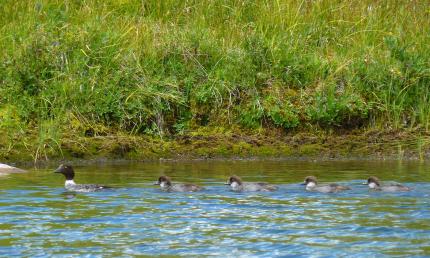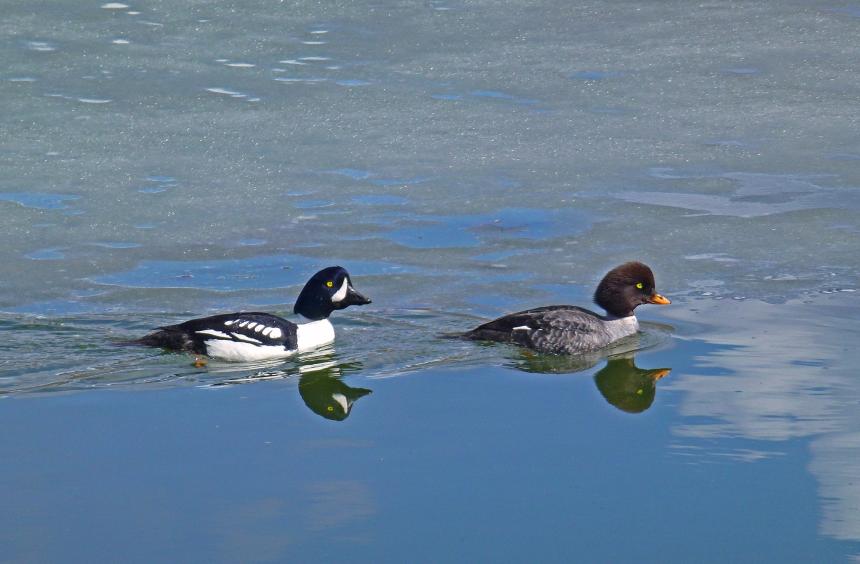This sea duck species breeds in Washington, has low population numbers, and has been declining in Puget Sound. Sources of impacts have not been clearly identified. Increasing development in the Puget Sound region has led to more disturbance, pollution, and degradation of foraging areas used by sea ducks. Some aquaculture practices may impact foraging areas through exclusion of sea ducks. Forest management activities may remove older trees and snags that provide most nest cavities and may increase predation at remaining cavities.
Barrow’s goldeneye is managed as a migratory game bird. Sea ducks are managed under state and federal migratory waterfowl regulations cooperatively through the Pacific Flyway Council.
Description and Range
Physical description
Two species of goldeneye call Washington home: Barrow’s goldeneye and common goldeneye. It can be difficult to tell females or “hens” of the two species apart, but the coloration of the hen’s bill is the best characteristic, with the Barrow’s goldeneye hen being more orange overall. The Barrow’s male or “drake” tends to be slightly larger than the common goldeneye drake, and it has a larger white, halfmoon-shaped spot between its eye and bill. Barrow’s goldeneye are about 19 inches in length and weigh about 2 ¾ pounds, whereas common goldeneye are about 19 inches in length and weigh about 2 ¼ pounds. Additionally, in comparison, Barrow’s goldeneye have much less white feathering on their back and shoulder (upper part of the wing) appearing as white dots surrounded by black body plumage on the male, and very little if any visible white on the female.
Drakes have a piercing “speer speer” vocalization, whereas hens have a low grumbly quack, but both are usually quiet. Goldeneye are active, strong-winged fliers, moving singly or in small flocks, often high in the air. They have a distinctive wing-whistling sound in flight, earning them the nickname of “whistlers.” For more information on how to identify the two species, check out the Sea Duck Joint Venture "Meet the Sea Ducks": Barrow's goldeneye and common goldeneye. Also check out the Resources section.
Ecology and life history
Barrow’s goldeneye is considered a sea duck as it is found in large numbers on saltwater during winter, but it is dependent upon freshwater lakes during breeding and brood rearing periods. Most Barrow’s goldeneyes wintering in Washington occur on Puget Sound bays, inlets, harbors, and rocky shores, and some use ice-free inland lakes, ponds, and rivers, particularly specific stretches of the Columbia River.
This species is a cavity nester, the female placing its nest in mature and late successional forests and riparian areas adjacent to low gradient rivers, sloughs, lakes, and beaver ponds. Barrow’s goldeneye have been confirmed to nest in forests of northeast Washington, the Cascades, and Olympic mountains. Females use tree cavities, including those excavated by pileated woodpeckers, and also nest in artificial nest boxes where natural cavities are limited. A unique occurrence of cliff nesting Barrow’s goldeneye has been documented along Lake Lenore in central Washington. Broods are reared in isolated freshwater lakes. Both male and female Barrow’s goldeneyes are territorial during the breeding season.

Animal matter can comprise over 75 percent of the diets of breeding Barrow's goldeneyes, including aquatic insects, mollusks, crustaceans, and small fish. During winter they feed in shallow water, primarily on mussels but also clams, crustaceans, and fish eggs.
Most wintering birds depart for breeding areas from mid-March to early April. Like other sea ducks, Barrow’s goldeneye adults are highly site-faithful to breeding, migration, and wintering use areas, breed at an older age, and have lower recruitment compared to other waterfowl. WDFW surveys in 2010 on Puget Sound recorded only 9.7% juveniles (hatched the previous summer) in the population, but birds of non-breeding age tend to aggregate in portions of the Puget Sound.
Geographic range
The breeding population of Barrow's goldeneye in the state is thought to be widespread within the Cascades and between Okanogan and Pend Oreille Counties. A unique population nests in cavities within the talus slopes and basalt cliffs surrounding Lake Lenore and Alkali Lake in central Washington.
Based on species composition surveys, approximately 20 to 25% of goldeneye flocks recorded on Puget Sound are comprised of Barrow’s goldeneye. The average winter population of Barrow’s goldeneye on Puget Sound was estimated at 10,807 during 2017 to 2020. Winter 2017 to 2020 counts of both goldeneye species combined (Barrow's and common) on Puget Sound were estimated at 42,946, but these counts have declined from estimates prior to 1996. The statewide breeding population of both goldeneye species averaged 420 between 2012 to 2019, but detection of breeding pairs is difficult from aircraft given their preferred forested pond wetland habitats and the majority of this preferred habitat would be located off of the traditional aerial transects flown across the state.
For maps of world-wide distribution and other species’ information, check out NatureServe Explorer and the Union for Conservation of Nature Red List.
Climate vulnerability
Sensitivity to climate change
Moderate
Barrow's goldeneye dependence on specific nesting, breeding, and wintering sites significantly increases this species' sensitivity to climate change. Disturbances such as fire could result in nesting tree loss, and changes in water chemistry (e.g., dissolved oxygen, pH) or temperature may lead to declines in food availability (e.g., mussels, aquatic insects, crustaceans, clams, etc.). Diminished snowpack that leads to wetland drying could also impact this species.
Exposure to climate change
Moderate
- Altered fire regimes
- Declines in pH and dissolved oxygen
- Reduced snowpack
- This species is considered "climate endangered" (i.e., projected to lose >50% of current global range by 2050) in the Audubon Birds and Climate Change Report.
Regulations
Rules and seasons
For current rules about hunting Barrow’s goldeneye in the state, be sure to check the Washington Game Bird and Small Game hunting regulations.
Conservation
Sea ducks are game species, managed under state and federal migratory waterfowl regulations cooperatively through the Pacific Flyway Council. The Pacific Flyway Council is an administrative body that forges cooperation among public wildlife agencies for the purpose of protecting and conserving migratory birds in western North America. The Council is composed of the director or an appointee from the public wildlife agency in each state and province in the western United States, Canada, and Mexico. Washington waterfowl hunters pursuing sea ducks in western Washington are required to record and report all harvest effort and activities, including for Barrow's goldeneye.
WDFW has various game management plans to track populations and harvest of games species around the state, including waterfowl. These plans have information about harvest statistics from recent years, and the department's long-term vision and goals for a variety of species.
In early 2003, WDFW formed the Washington Waterfowl Advisory Group (WAG) to increase citizen involvement in the conservation and management of Washington’s waterfowl resources. This group has members from a broad representation of waterfowl hunters throughout the state. To learn about the WAG, contact the WDFW Waterfowl Section at (360) 902-2515 or visit the WAG webpage.
Conservation Threats and Actions Needed
- Resource information collection needs
- Threat: Lack of Information on status and distribution.
- Action Needed: Conduct annual winter inventory.
- Threat: Lack of information on population demography.
- Action Needed: Conduct periodic recruitment and species composition surveys.
- Threat: Range-wide delineation of Puget Sound winter population.
- Action Needed: Develop satellite telemetry study to document use areas.
- Fish and wildlife habitat loss or degradation.
- Threat: Development impacts on breeding and wintering habitat.
- Action Needed: Document and address limiting factors.
See the Climate vulnerability section for information about the threats posed by climate change to this species.
Our Conservation Efforts
Midwinter Aerial Seabird Surveys
WDFW conducts survey flights over a period of several days from November through February annually to monitor the abundance, trends, and distribution of sea ducks and other marine birds in the Puget Sound and the Strait of Juan de Fuca (U.S. portion of the Salish Sea). Learn more about this research on the project's page.
Resources
References
Sea Duck Joint Venture Species Fact Sheet – Barrow's Goldeneye
WDFW. 2013. Washington Sea Duck Management Strategies - Draft Report to the Washington Fish and Wildlife Commission.16 pgs.
WDFW publications
- Washington Sea Duck Management Strategies - Draft Report to the Washington Fish and Wildlife Commission (2013)
- The Basics of Waterfowl Hunting in Washington (PDF)
Other resources
- U.S. Fish and Wildlife Service - Overview: Barrow’s Goldeneye
- U.S. Fish and Wildlife Service - Ducks at a Distance: A Waterfowl Identification Guide
- U.S. Fish and Wildlife Service - Aerial Observer’s Guide to North American Waterfowl
- Sea Duck Joint Venture - A Conservation Partnership under the North American Waterfowl Management Plan
- Cornell Lab All About Birds - Barrow's Goldeneye
- eBird Northwest - Barrow's Goldeneye


